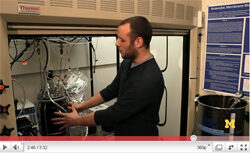Adam Smith keeps the lab fridge stocked with partially-treated sewage. It’s one of the less glamorous parts of his civil and environmental engineering Ph.D. work. Every few weeks, he takes a field trip to the Dundee, Michigan treatment plant, where he fills a couple jugs with murky liquid.”It doesn’t smell the greatest, but you get used to it,” Smith said.He’s working on a project that aims to turn toilet water into a source of energy and maybe even drinking water. Tag along with him on a visit to the treatment plant in this video:http://www.youtube.com/watch?v=CrBFDkDtJvsThis project is run out of the lab of professor Lutgarde Raskin, in the Department of Civil and Environmental Engineering. She and her collaborators have developed what’s called an anaerobic membrane bioreactor that could make this transformation of municipal wastewater to energy possible.The bioreactor is a kettle-sized vat in which the researchers mix the partially-treated sewage with a stew of microbes that don’t need oxygen to live. The micobes eat the organic matter in the wastewater and digest it. It’s a process kind of like beer-making, but the result in this case is methane, which can be converted to a natural gas-like fuel that can, in turn, produce electricity. In the bioreactor, a plastic pouch collects the methane as the microbes release it.This microbial process of breaking down the organics in the sewage and turning them into fuel also continues to clean the water. Special membranes in the bioreactor filter the organisms from the fluid they’re treating. The clear water that drips out of the bioreactor is clean enough to be released into a river. With a few more steps, it could be treated to drinking water standards. That’s something the researchers aim to demonstrate in future studies.Anaerobic, or oxygen-free, techniques that can produce energy are used today sometimes to treat really dirty industrial wastewater. Sewage is comparatively clean, Smith says, and that makes it harder to treat this way. This project is unique in that it accomplishes the conversion of this so-called low-strength municipal waste, and at relatively cool temperatures.”Anaerobic bacteria tend to like higher temperatures and that has been one of the inhibitors of this kind of treatment. If we want to do this at a wastewater treatment plant in the winter in Michigan, we need to show it can work at well below room temperature,” said Steve Skerlos, an associate professor of mechanical and civil and environmental engineering and a project collaborator.So far they’ve demonstrated that it works at 59 degrees Fahrenheit.Ideally, this research could enable municipal wastewater treatment plants to power themselves.”I’m fascinated,” Smith said, “by looking at wastewater as a resource.”
Turning toilet water into energy and drinking water



